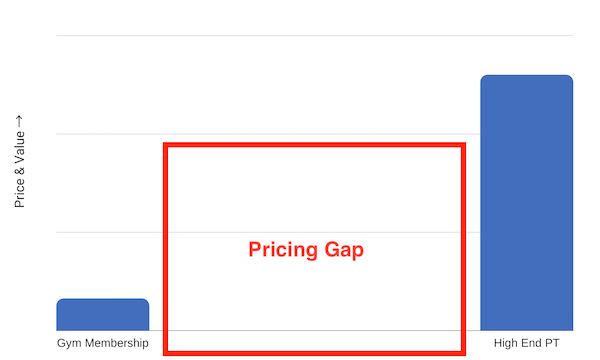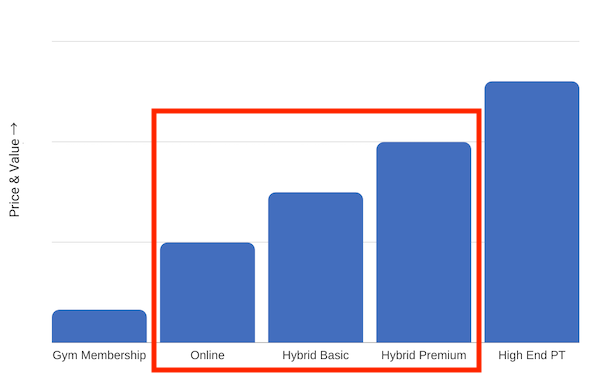
Gyms are gradually re-opening their doors around the country – but not without constraints.
Boost Your Client Retention with Trainerfu– Start Now!
Engage clients better and improve retention with Trainerfu’s features.
Try it freeMost states require gyms to reduce their capacity by 75% and follow social distancing guidelines. As more people become comfortable with the idea of coming back to the gym, supporting all members and meeting strict guidelines has the potential to become a logistical nightmare.
On top of that, gyms across the board can expect:
- A decline in revenue from membership and group training as many people look to avoid gyms for safety reasons.
- A decline in revenue from personal training as affordability takes a major hit due to the economic downturn.
In this "new normal" condition, can gyms expect to work within these constraints, serve all of their members and still meet their bottom line?
The answer: 100% Yes. But not by doing things the old way.
In this post, we'll look into the new hybrid model for fitness training. We use the term "hybrid" because this model uses online training in combination with on-location training, allowing your business to:
- Comply with the new restrictions but still support 100% of your members.
- Increase the total revenue earned per member so that you can recover any lost revenue due to cancellations.
- Make your fitness business resilient so that you can easily adapt with changing times and come out of the crisis better and stronger than ever.
Let's take a deeper dive and see how the hybrid model delivers each benefit:
Part 1: Support 100% of your members, even with reduced capacity
When you are restricted to 25% capacity, you have no choice but to restrict when and how many times a member can come to the gym.
If you want to continue delivering the same experiences that justify charging pre-covid rates, you need to add value to your members' training outside your gym. How? With online training.
Below is the 2-step method that we highly recommend:
Step 1: Manage capacity at your gym effectively
Have a booking system in place, and require clients to book their slot to come to the gym to do their workouts.
For peak hours, limit the number of slots a person can book to 2 per week, maximum.
Step 2: Deliver value outside of the gym with group online training programs
Create a few different group training plans, each with different goals (for example, fat loss or muscle gain). Be sure to include lots of extra perks. This includes anything from recipe guides to fresh educational content each day, including videos, that are tailored to each program.
Have a dedicated web page where clients can go and sign up for the plan that works best with their goals – then follow through with delivering.
A Note Here: You can set all this up easily through the fitness training app TrainerFu, starting from client signup to delivering your group training. At the end of this article, you'll see a link with information on how to set up a group training in TrainerFu.
Part 2: Increase the average revenue earned per client
The average cost of a personal training session in the U.S. is about $65. A client who takes two sessions per week pays around $520 per month – a bit expensive for most people. On the other hand, an average gym membership costs just $65 per month.
This creates a big pricing gap between gym membership and private training, leaving few choices for prospects who are looking for personalized training options somewhere in the middle.
For example, a prospect who has $250 per month to spend on personalized fitness will most likely end up getting a gym membership and decide to pocket the remaining $185.

The reason for this pricing gap is simple. Exclusive, one-on-one training requires a lot of in-person time from a personal trainer. And, if a trainer is spending eight hours per month on a client, there's no way to lower the price below $500 without sacrificing profitability.
On the other hand, online training is much cheaper since it doesn't require any in-person time from a personal trainer. But online training may not be right fit for everyone at your gym.
So how can you capture the demand of mid-pricing personalized training and meet the diverse needs of your clients?
The key is to use online training in conjunction with in-person training.
Let's look at a hypothetical example to see this in action:

Gym A has added three new products to fill the mid-pricing gap: online, hybrid basic and hybrid premium. Below are details about each package:
Online
Total hours per month required to train a client: 3
Number of in-person sessions: 0
Price: $199 per month
Hybrid Basic
Total hours per month required to train a client: 4
Number of in-person sessions: one every two weeks (biweekly)
Price: $299 per month
Hybrid Premium
Total hours per month required to train a client: 6
Number of in-person sessions: 1 per week
Price: $399 per month
Online training is a great option for experienced clients and clients on a tight schedule who need more flexibility.
However, this method probably isn't suitable for beginner and intermediate clients who need more guidance. In these cases, hybrid personal training may be a better fit.
Hybrid personal training is a combination of in-person and online training. In this format, you still meet with clients – just less frequently. The in-person training sessions are used primarily to perform assessments, review the client's progress, and demonstrate new exercises and correct form.
What makes this model for personalized training so awesome? Here are the 6 top reasons:
1. More upgrades.
Specifically, the online and hybrid service fill the unmet needs of lots of clients. The types of clients and their needs include:
- Clients looking for affordable personalized training.
- Clients with a tight schedule looking for flexible options.
- Clients who are experienced and need help with designing a workout program.
- Clients looking to keep themselves safe during these uncertain times.
With the hybrid model you can capture this untapped demand and sell them more upgraded plans instead of leaving them stuck at a base membership plan.
2. Lower attrition rates
Life happens and situations change; a training option that is ideal today may not be ideal tomorrow.
With that in mind, offering a range of fitness options will allow your clients to upgrade or downgrade to suit their changing needs – rather than leaving your business altogether.
3. Increase average revenue per member
More upgrade and lower attrition means you earn more per client over that client's lifetime.
4. Clients' safety
Provide a great option for your clients who want to avoid the gym. Both online and hybrid options allow the user to minimize contact and stay healthy at home.
5. Increase capacity
More workouts at home and less workouts at the gym means it is easier for you to manage the capacity of your B&M business.
6. Subscription pricing
Online training allows you to deliver value to your prospects both during and after their in-person training session.
There's no longer any need for per-session pricing, and it should be fairly easy for you to sell monthly pricing to your prospects. Plus, the subscription model allows you to sell once and be done, bringing you dependable revenue.
Part 3: Make Your Fitness Business More Resilient.
The hybrid model will provide you the resilience you need during these uncertain times. You'll be in a better position to adapt to changing needs. Imagine the following situations:
- You are forced to limit your gym only to personal training. Affordable hybrid plans will be great options for the majority of your clients.
- You are asked to close your doors due to a 2nd wave. You can seamlessly move all your clients to online training and keep them healthy and active.
- All restrictions are eventually lifted. In this case, you have already developed a robust and unique business model that will help you stand out from the crowd. You are also a step ahead of your competitors in case another situation ever occurs in which you have to temporarily close your B&M establishment.
Final Thoughts
Note that online training isn't just sending workouts to your clients. That alone isn't anything special.
Online Training, instead, is a way for you to deliver an amazing experience to your clients outside your gym – and TrainerFu has already built a platform that will help you through the whole process.
In addition to delivering workouts, TrainerFu enables you to provide unparalleled support and accountability with all your services, as well as include unique benefits like nutrition coaching, habit coaching and fitness education.
There's a reason that TrainerFu is the best-rated app for personal trainers in both the Apple app store (★★★★★ 4.8/5.0, 1600 ratings) and Google Play (★★★★★ 4.7/5.0, 412 ratings).
If you haven't already, sign up for the TrainerFu free trial today. It's easy to get started and get results before committing to a subscription, and both you and your clients will be happier for it.
Frequently Asked Questions
1. What is a hybrid gym model?
A hybrid gym model combines traditional in-person gym training with online training options, providing clients with flexibility to work out at the gym or remotely.
2. Why should gyms adopt a hybrid model?
Hybrid models offer greater flexibility for clients, help gyms adapt to capacity restrictions, and open new revenue streams through online services.
3. How can gyms manage capacity with a hybrid model?
Gyms can implement booking systems for in-person visits and offer virtual classes or training programs to reduce onsite crowding.
4. What tools are needed for a hybrid gym model?
Fitness apps, video conferencing tools, and management platforms that support program creation, scheduling, and client communication are essential.
5. What challenges do gyms face when transitioning to a hybrid model?
Challenges include managing technology adoption, maintaining service quality online, and effectively marketing the new services to existing and potential clients.
6. What pricing strategies work for a hybrid gym model?
Offering tiered pricing for gym-only, virtual-only, and hybrid memberships ensures affordability and caters to diverse client needs.